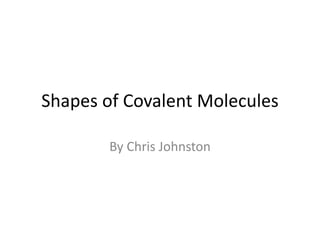
Shapes of covalent molecules
- 1. Shapes of Covalent Molecules By Chris Johnston
- 2. Regular Covalent Molecules C OO C H H H H
- 3. Figuring out the Shape of a Regular Covalent Molecule 1. In the Bond, pick out the ‘main’ atom and work out how many electrons it has in the outer energy level. Cl4C 1 12 23 34 4
- 4. Figuring out the Shape of a Regular Covalent Molecule 2. Draw out a completed dot and cross diagram of the molecule to make sure there are no lone pairs of electrons. Also count the number of bonded pairs. Cl Cl Cl Cl Lone Pairs: Bonded Pairs: 0 01234
- 5. Figuring out the Shape of a Regular Covalent Molecule 3. Using the number of bonded pairs, find out the shape of the regular molecule. No. of Bonded Pairs Name of Shape 3D Shape 2D Shape + Example Bond Angles. 2 Linear C OO CO2 180°3 Trigonal Planar B F F F BF3 120°4 Tetra- hedral C H H H H CH4 109.5°5 Trigonal Bipyramidal P Cl Cl Cl Cl Cl PCl5 90° + 120° 6 Octahedral S F F F F F F SF6 90°
- 8. Figuring out the Shape of an Irregular Covalent Molecule 1. In the Bond, pick out the ‘main’ atom and work out how many electrons it has in the outer energy level. Cl3P 1 12 2334 45 5
- 9. Figuring out the Shape of an Irregular Covalent Molecule 2. Draw out a completed dot and cross diagram of the molecule and count the number of bonded and lone pairs of electrons. P Cl Cl Cl Lone Pairs: Bonded Pairs: 0 0123 1
- 10. Figuring out the Shape of an Irregular Covalent Molecule 3. Use the total number of pairs to figure out what shape it is based on, then place the lone pair of electrons. Total Pairs = Bonded Pairs + Lone Pairs Total Pairs = 3 + 1 Total Pairs = 4 P Cl Cl Cl
- 11. Figuring out the Shape of an Irregular Covalent Molecule 4. Use the angle of the regular shape, and the number of lone pairs, to figure out the new bond angle. X X X Strength of Repulsion Bonding Angle = Angle of Regular Shape - (Number of lone pairs x 2.5) P Cl Cl Cl 109.5° - 2.5° = 107°
- 12. Covalent Ions O H[ ]- N HH[ ] -
- 13. Figuring out the Shape of a Covalent Ion 1. In the bond, pick out the ‘main’ atom and work out how many electrons it has in its outer energy level. Keep the charge in mind! H3O+
- 14. Figuring out the Shape of a Covalent Ion 2. Draw out a completed dot and cross diagram of the molecule and count the number of bonded and lone pairs of electrons. Lone Pairs: Bonded Pairs: 0 0123 1
- 15. Figuring out the Shape of a Covalent Ion 3. Use the total number of pairs to figure out what shape it is based on, then place the lone pair of electrons. Total Pairs = Bonded Pairs + Lone Pairs Total Pairs = 3 + 1 Total Pairs = 4 O+ H H H
- 16. Figuring out the Shape of a Covalent Ion 4. Use the angle of the regular shape, and the number of lone pairs, to figure out the new bond angle. Bonding Angle = Angle of Regular Shape - (Number of lone pairs x 2.5) O+ H H H Bond Angle = 109.5° - 2.5 ° Bond Angle = 107 °
